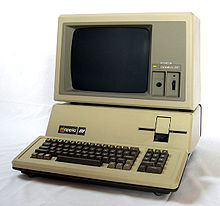
Back Apple III BS Apple III Catalan Apple III Czech Apple III German Apple III Greek Apple III Spanish اپل III Persian Apple III Finnish Apple III French Apple III HE
This article has multiple issues. Please help improve it or discuss these issues on the talk page. (Learn how and when to remove these messages)
|
 | |
 | |
| Developer | Apple Computer |
|---|---|
| Release date | November 1980[1] |
| Introductory price | US$4,340 – $7,800 (equivalent to $16,050 – $28,840 in 2023)[2] |
| Discontinued | April 24, 1984 |
| Units sold | 65,000–75,000 |
| Operating system | Apple SOS |
| CPU | Synertek 6502B @ 1.8 MHz |
| Memory | 128 KB of RAM, expandable to 512 KB |
| Removable storage | 5+1⁄4 inch floppy disk |
| Display | 80×24 text 560×192 pixels (monochrome) 280×192 pixels (16 colors or grayscale) |
| Sound | 6-bit DAC |
| Predecessor | Apple II |
| Successor | Apple III Plus Apple Lisa |
The Apple III (styled as apple ///) is a business-oriented personal computer produced by Apple Computer and released in 1980. Running the Apple SOS operating system, it was intended as the successor to the Apple II, but was largely considered a failure in the market. It was designed to provide features business users wanted: a true typewriter-style keyboard with upper and lowercase letters (the Apple II only supported uppercase at the time) and an 80-column display.
It had the internal code name of "Sara", named after Wendell Sander's daughter.[3] The system was announced on May 19, 1980, and released in late November that year.[4] Serious stability issues required a design overhaul and a recall of the first 14,000 machines produced. The Apple III was formally reintroduced on November 9, 1981.[4][5][better source needed]
Damage to the computer's reputation had already been done, however, and it failed to do well commercially. Development stopped, and the Apple III was discontinued on April 24, 1984. Its last successor, the III Plus, was dropped from the Apple product line in September 1985.[3]
An estimated 65,000–75,000 Apple III computers were sold.[5][3] The Apple III Plus brought this up to approximately 120,000.[3] Apple co-founder Steve Wozniak stated that the primary reason for the Apple III's failure was that the system was designed by Apple's marketing department, unlike Apple's previous engineering-driven projects.[6] The Apple III's failure led Apple to reevaluate its plan to phase out the Apple II, prompting the eventual continuation of development of the older machine. As a result, later Apple II models incorporated some hardware and software technologies of the Apple III.
- ^ Linzmayer 2004, pp. 42–43.
- ^ VAW: Pre-PowerPC Profile Specs Archived February 13, 2008, at the Wayback Machine
- ^ a b c d Linzmayer 2004, pp. 41–43.
- ^ a b Linzmayer 2004, pp. 41–42.
- ^ a b Stenger, Steven. "Apple III". oldcomputers.net. Archived from the original on November 24, 2021. Retrieved August 1, 2009.
- ^ Wozniak, S. G. (2006). iWoz: From Computer Geek to Cult Icon: How I Invented the Personal Computer, Co-Founded Apple, and Had Fun Doing It. W. W. Norton & Company. ISBN 0-393-06143-4. OCLC 502898652.